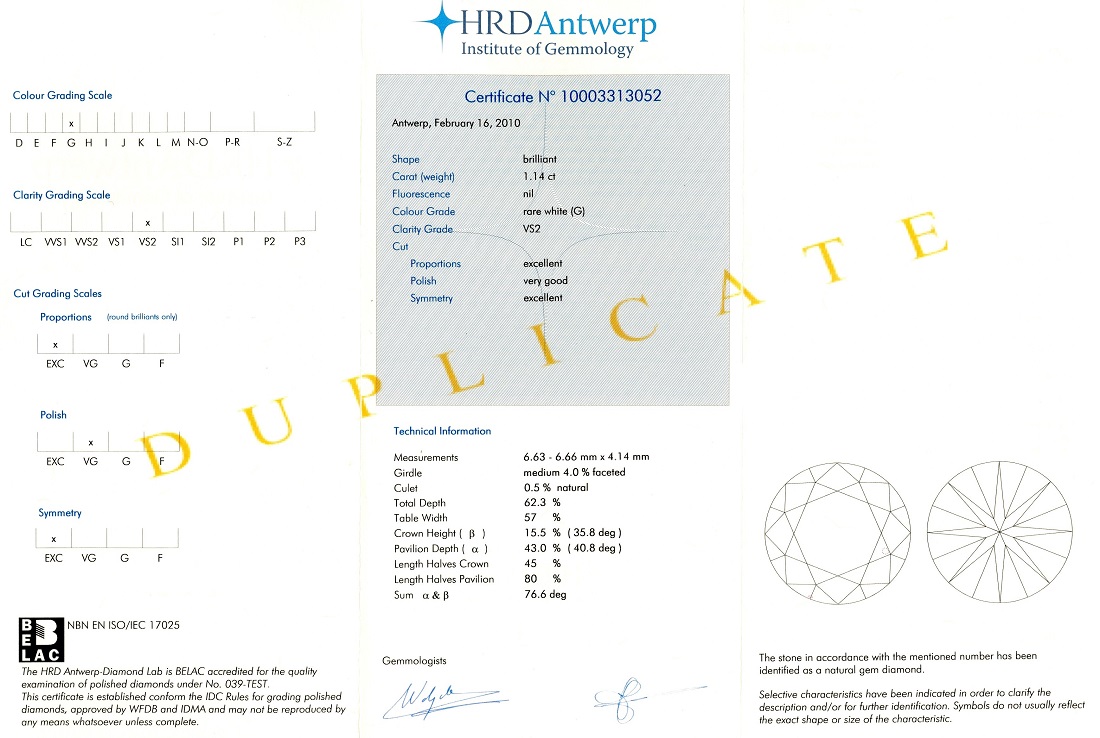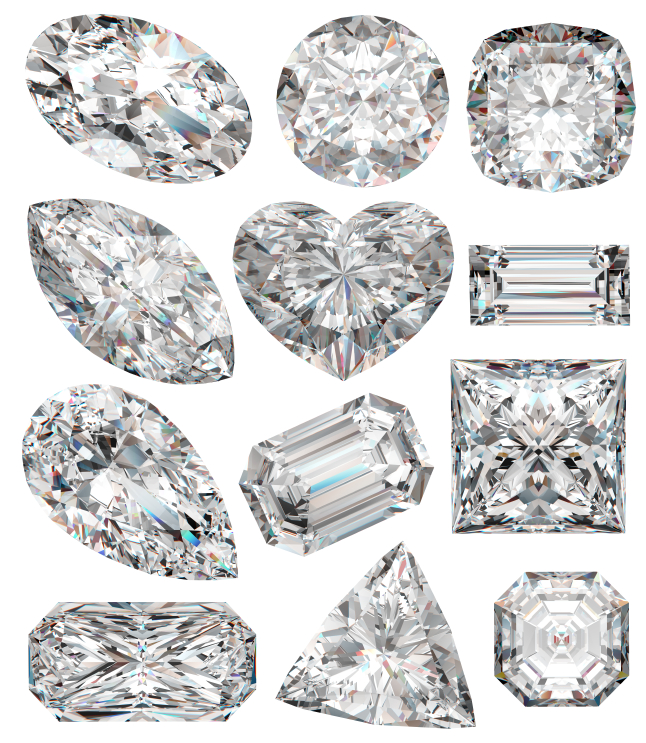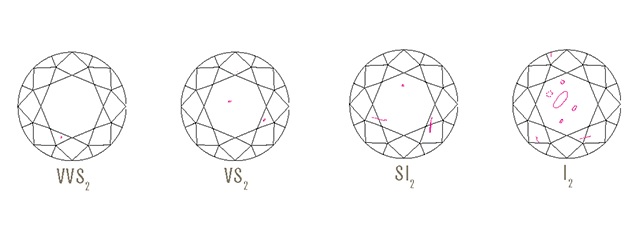
Diamond Education Center
All Golf Events Today diamonds come with a recent official certificate from the Hoge Raad voor Diamant (HRD Antwerp - www.hrdantwerp.be), which is the coordinating body and official representative of the Belgian diamond sector.

Carat
The standard unit of weight for diamonds and other gemstones is the metric carat: one carat is equal to 0.2 grams. A carat is divided into 100 points. For example, a 70-point diamond weighs 0.70 carats.
The carat takes its name from the carob seed. Because these small seeds had a fairly uniform weight, early gem traders used them as counterweights in their balance scales. The modern metric carat was adopted by the United States in 1913 and other countries soon after. Today, a carat weighs exactly the same in every corner of the world.
Even with modern techniques, the cutting and polishing of a rough diamond crystal always results in a dramatic loss of weight; rarely is it less than 50%. Round brilliants have certain requisite proportions which result in higher weight loss, whereas fancy cuts are typically much more flexible in this regard. Sometimes the cutters compromise and accept lesser proportions and symmetry in order to avoid inclusions or to preserve carat weight, since the per-carat price of diamond is much higher when the stone is over one carat (200 mg).
Be careful not to confuse carat with karat, as in “18K gold”, which refers to gold purity.
Cut
The mined rough diamonds are converted into gemstones through a multi-step process called "cutting". Diamond cutting is traditionally considered as a delicate procedure requiring skills, scientific knowledge, tools and experience.
Cut does not refer to shape, but to the Symmetry, Proportions and Polish of a diamond. The cut precision of a diamond greatly impacts a diamonds’ brilliance and is crucial to avoid dull, lifeless stones.
An understanding of diamond cut begins with the shape of a diamond. A “fancy cut” is any cut other than a round brilliant.
- (Standard) round brilliant
- Princess cut square - inverted pyramid)
- Marquise
- Pear (Teardrop)
- Oval
- Emerald
- Heart
- Cushion
- Triangle (also trillian or trilliant)

The allure of a particular diamond depends more on cut than anything else. Cut is the factor that fuels a diamond’s:
- Brilliance: The total light reflected from a diamond.
- Fire: The dispersion of light into the colors of the spectrum.
- Scintillation: The flashes of light, or sparkle fonkeling, when a diamond is moved.
The Gemological Institute of America (GIA) diamond cut grading system for standard round brilliants assigns an overall diamond cut grade ranging from:
- Excellent
- Very good
- Good
- Medium
- Poor
Fancy cuts are not held to the same strict standards as Tolkowsky-derived round brilliants.
Color
Diamond color is all about what you can’t see. Diamonds are valued by how closely they approach colorlessness – the less color, the higher their value.
The Gemological Institute of America (GIA) color grading scale for diamonds begins with the letter D, representing colorless, and continues with increasing presence of color to the letter Z, or near-colorless. Each letter grade has a clearly defined range of color appearance.
Because the creators of the GIA color grading scale wanted to start fresh, without any association with earlier systems (using letters of the alphabet {A, B and C, with multiple A’s for the best stones}, Arabic {0, 1, 2, 3} and Roman {I, II, III} numerals), they chose to start with the letter D, a letter grade normally not associated with top quality.
GIA color grading:
- Exceptional white+ D
- Exceptional white E
- Rare white+ F
- Rare white G
- White H
- Slightly tinted white+ I
- Slightly tinted white J
- Tinted white+ K
- Tinted white L
- Tinted colour M-Z

Diamonds are color-graded by visually comparing them to a set of master stones of known color under controlled lighting and precise viewing conditions.
The exception to the GIA’s color-grading scale is fancy-color diamonds, such as pinks and blues, which lie outside this color range. Colors in diamond originate from lattice defects and impurities. The diamond crystal lattice is exceptionally strong and only atoms of nitrogen, boron and hydrogen can be introduced into diamond during the growth at significant concentrations (up to atomic percents). Nitrogen is by far the most common impurity found in diamonds. Nitrogen is responsible for the yellow and brown in diamonds. Boron is responsible for the gray blue colors. Color in diamond has two additional sources: - Irradiation (usually by alpha particles), that causes the color in green diamonds. - Plastic deformation (physical deformation of the diamond crystal), the cause of color in some brown and perhaps pink and red diamonds.
Fluoresence: Natural blue fluorescence is the emission of visible blue light by a diamond that has absorbed light of any source of invisible ultraviolet light.
Clarity
Because diamonds are formed deep within the earth, under extreme heat and pressure, they often contain unique birthmarks, either internal (inclusions) or external (blemishes). Diamond clarity refers to the absence of these inclusions and blemishes. Diamonds without these birthmarks are rare, and rarity affects a diamond’s value.
The Gemological Institute of America (GIA) Clarity Scale contains 11 clarity grades that range from flawless (FL) to diamonds with obvious inclusions (I3), clearly visible to the human eye.
GIA clarity:
- Flawless (FL): No inclusions or blemishes are visible to a skilled grader using 10× magnification
- Internally Flawless (IF): No inclusions and only blemishes are visible to a skilled grader using 10× magnification
- Very, Very Slightly Included (VVS1 and VVS2): Inclusions are difficult for a skilled grader to see under 10× magnification
- Very Slightly Included (VS1 and VS2): Inclusions are clearly visible under 10× magnification but can be characterized as minor
- Slightly Included (SI1 and SI2): Inclusions are noticeable to a skilled grader using 10× magnification
- Included (I1, I2, and I3): Inclusions are obvious under 10× magnification and may affect transparency and brilliance

Brilliance
Refraction of light
The refractive index (n) of a medium is defined as the ratio of the velocity (c) of a wave phenomenon (such as light or sound) in a reference medium, to the phase velocity (vp) in the medium itself. The refractive index of a medium is a measure of how much the speed of light (or other waves) is reduced inside the medium. The higher the index of the material, the more the light is slowed down.
When light crosses a boundary between materials with different refractive indices (n), the light beam will be partially refracted at the boundary surface, and partially reflected.
Refractive Index
The angle of incidence θ1 is measured with respect to the normal N at the refractive boundary. As n2 > n1, the phase velocity is lower in the second medium (v2 < v1), the angle of refraction θ2 is less than the angle of incidence θ1. The ray in the higher-index medium is closer to the normal N.
Total Internal Reflection
The larger the angle of incidence θ1 to the normal N, the smaller is the fraction of light transmitted, until total internal reflection (TIR) occurs. Total internal reflection (TIR) is an optical phenomenon that occurs when a ray of light strikes a medium boundary at an angle of incidence θ1 larger than a particular critical angle θc with respect to the normal N to the surface. The critical angle θc is the angle of incidence θ1 above which the total internal reflection occurs.
When light travels from a medium with a higher refractive index (diamond n = 2,417) to one with a lower refractive index (air), the light will stop crossing the boundary altogether and all of the light is reflected back internally.
The brilliant cut is designed to achieve high total reflection of light entering the diamond. The critical angle for diamond in air is about 24,4°, which means that light is likely to be internally reflected within an excellent cut diamond.
Diamond Brilliance
Diamond brilliance is defined as the amount of incident light reflected from the facets of a diamond, to your eye.
Brilliance can be divided into external brilliance (glare) and internal brilliance:
External brilliance (glare): About 20% of the light that falls on a diamond is reflected from the surface of the stone to your eyes. Diamond has the highest reflectivity of all gemstones because it has the highest refractive index (n) and because diamond takes the best polish of all materials (because it is so hard). A beautifully polished diamond provides maximum luster from its surfaces. Glare is not particularly dependant on the proportions of the facets.
Internal brilliance: The remaining 80% of light enters the diamond via the table and crown facets. The pavilion facets reflect this light around inside the stone until it comes back out. Many light paths reflect considerably more than two times within a diamond.
The art of diamond cutting is to position facets so that most of this light leaves the diamond via the table or the crown facets.
In the best proportioned brilliant about 80% of the light which entered via the crown exits again out of the top (where it can be seen as bright facets). Light that leaves the back or out the pavilion of the diamond is called leakage.
Internal brilliance relies on the cut's interfacial angles. A well-cut diamond will direct more light through the crown. The goal is to attain total internal reflection (TIR) by choosing the crown angle and pavilion angle such the reflected light's angle of incidence (when reaching the pavilion facets) falls outside diamond's critical angle (24,4°).
How does pavilion depth affect a diamond's brilliance?
The pavilion angle and pavilion depth (the distance from the bottom of the girdle to the culet) are closely tied to total internal reflection (TIR) and consequently to diamond brilliance. A pavilion depth that’s too shallow or too deep will allow light to escape through the sides or the bottom of the stone.
- If the pavilion is too shallow, light meets the pavilion facets within the critical angle, and is refracted through the pavilion bottom into the air (leakage).
- If the pavilion is too deep, light is initially reflected outside the critical angle on one side of the pavilion, but meets the opposite side within the critical angle and is then refracted out the side of the stone.
Additional information can be found on the official website of the Gemological Institute of America Inc.
You remain always welcome to contact us at stefaan.deknijf@golfevents.today or +32 3 295 91 42.
With kind regards,
ir. Stefaan De Knijf
General Manager
Golf Events Today